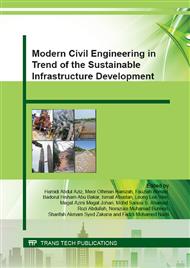[1]
W. K. Campbell. Prediction of strong ground motion using the hybrid empirical method and its use in the development of ground-motion (attenuation) relations in eastern North America., Bulletin of the Seismological Society of America. 93(3) (2003).
DOI: 10.1785/0120020002
Google Scholar
[2]
A. Adnan, Hendriyawan, and I. Masyhur. Selection and Development of Appropriate Attenuation Relationship for Peninsular Malaysia., Proceeding Malaysian Science and Technology Congress, Mid Valley, Kuala Lumpur (2004).
Google Scholar
[3]
R. Youngs, S. J. Chiou, W. Silva and J. Humphrey. Strong ground motion attenuation relationships for subduction zone earthquakes., Seismological Research Letters. 68(1) (1997) 58-73.
DOI: 10.1785/gssrl.68.1.58
Google Scholar
[4]
M. D. Petersen, J. Dewey, S. Hartzell, C. Mueller, S. Harmsen, A. Frankel, and K. Rukstales. Probabilistic seismic hazard analysis for Sumatra, Indonesia and across the Southern Malaysian Peninsula., Tectonophysics. 390(1) (2004) 141-158.
DOI: 10.1016/j.tecto.2004.03.026
Google Scholar
[5]
K. Megawati, T. C. Pan, and K. Koketsu. Response spectral attenuation relationships for Sumatran-subduction earthquakes and the seismic hazard implications to Singapore and Kuala Lumpur., Soil Dynamics and Earthquake Engineering. 25(1) (2005).
DOI: 10.1016/j.soildyn.2004.08.003
Google Scholar
[6]
A. Nabilah and T. Balendra. Seismic hazard analysis for Kuala Lumpur, Malaysia., Journal of Earthquake Engineering. 16(7) (2012) 1076-1094.
DOI: 10.1080/13632469.2012.685208
Google Scholar
[7]
T.C. Van, and T. L. Lau. Estimation of ground motion in Kuala Lumpur due to Sumatra subduction earthquake., Proceedings of the International Civil and Infrastructure Engineering Conference 2013 (InCIEC 2013) (2014) 129-139.
DOI: 10.1007/978-981-4585-02-6_12
Google Scholar
[8]
H. Husen, T. A. Majid, F. M. Nazri, M. R. Arshad, and A. Faisal. Development of Design response Spectra Based on Various Attenuation Relationships at Specific Location., In International Conference on Construction and Building Technology (ICCBT08) (2008).
DOI: 10.17265/1934-7359/2013.12.004
Google Scholar
[9]
A. Adnan, Z. S. Shaerliza, S. Sumio, and G. Hiroyuki. An investigation of the attenuation characteristics of distant ground motions in Peninsular Malaysia by comparing values of recorded with estimated PGA and PGV., Malaysian Journal of Civil Engineering. 2(1) (2010).
Google Scholar
[10]
T.C. Van. Evaluation of existing ground motion attenuation models for the application in Peninsular Malaysia. MSc. degree thesis (2014) School of Civil Engineering, Universiti Sains Malaysia.
Google Scholar
[11]
Y. Fukushima and T. Tanaka. A new attenuation relation for peak horizontal acceleration of strong earthquake ground motion in Japan., Bulletin of the Seismological Society of America. 80(4) (1990) 757-783.
DOI: 10.1785/bssa0820010521
Google Scholar


